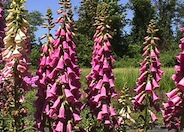
Common name:Blue Dawn Flower
Botanical name:Ipomoea indica
This perennial vine will grow 15'-30' tall and has dark green leaves wtih clusters of bright blue/purple flowers that bloom from spring to fall. It blooms in one year if planted by seed. It covers a chain link fence or even an entire wall. Leaves burn with frost or temperatures around 25 degrees F. However, the roots are not affected and it will come back with warmer weather. This plant is also called Morning Glory. No fertilizer needed.

Common name:Lion's Tail
Botanical name:Leonotis leonorus
This is an upright shrub to about 6' tall and wide. Lion's Tail provides both lush greenery and a durable, drought-tolerant shrub. Tubular, bright orange flowers are produced from summer through fall. Plants thrive in desert heat, and can be grown in containers, so plants can be moved to sheltered locations for frost protection.

Common name:Mediterranean Fan palm
Botanical name:Chamaerops humilis
Slow growing to 20' tall but very hardy, the Mediterranean Fan palm is clump forming with rich green foliage. It can be used as a good container subject. It does best in full sun or partial shade. Petioles have sharp spines.

Common name:Common Foxglove
Botanical name:Digitalis purpurea
This biennial foxglove will reach up to 4' when blooming in the early summer. The large spire of huge, bell-shaped flowers ranges from purple to pink to cream with purple specks. Large, textured leaves form an attractive rosette until bloom time. The plant likes a moist, filtered-sun area similar to the Lobelias and Columbines. -Holland Wildflower Farm
Pest Management
Are pests bugging you? If pests are taking over there might be a good reason! Instead of grabbing that bottle of spray, consider using techniques that can solve your pest problems without toxic pesticides.
Click in the green box for more information
| Designer: | Arch of Blue |
Photographer: GardenSoft |
Soils and Compost:
Incorporate compost 6" into your soil to retain water, reduce compaction, feed earthworms, and provide valuable nutrients to your plants.
Water Saving Tip:
Be sure to fix all leaks promptly no matter how small they may seem.
Integrated Pest Management:
Develop healthy soil for plants that are vigorous and naturally pest-resistant.

